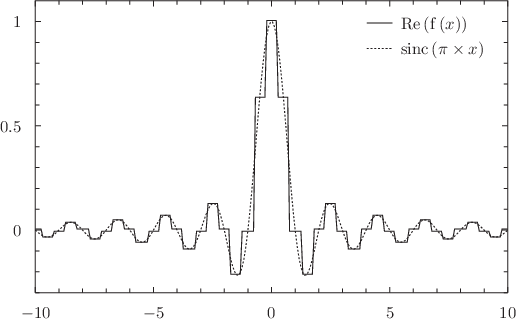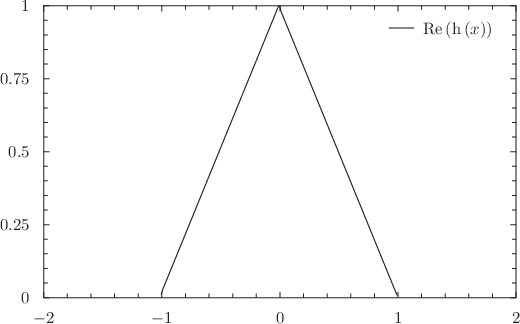5.8 Fourier transforms
The fft and ifft commands take Fourier transforms and inverse Fourier transforms respectively of data. As with other commands, data can be supplied from a data file, from functions, or from a colon-separated list of vectors (see Section 6.5.3). In each case, a regular grid of abscissa values must be specified on which to take the discrete Fourier transform, which can extend over an arbitrary number of dimensions. The following example demonstrates the syntax of these commands as applied to a two-dimensional top-hat function:
step(x,y) = tophat(x,0.2) * tophat(y,0.4) fft [ 0: 1:0.01][ 0: 1:0.01] f() of step() ifft [-50:49:1 ][-50:49:1 ] g() of f()
In the fft command above,  equally-spaced samples of the function step
equally-spaced samples of the function step are taken between limits of
are taken between limits of  and
and  for each of
for each of  equally-spaced values of
equally-spaced values of  on an identical raster, giving a total of
on an identical raster, giving a total of  samples. These are converted into a rectangular grid of
samples. These are converted into a rectangular grid of  samples of the Fourier transform f
samples of the Fourier transform f at
at
 |
 |
 |
|||
 |
 |
 |
where  and
and  is analogously defined. These samples are interpolated stepwise, such that an evaluation of the function f
is analogously defined. These samples are interpolated stepwise, such that an evaluation of the function f for general inputs yields the nearest sample, or zero outside the rectangular grid where samples are available. In general, even the Fourier transforms of real functions are complex, and their evaluation when complex arithmetic is not enabled (see Section 4.5) is likely to fail. For this reason, a warning is issued if complex arithmetic is disabled when a Fourier transform function is evaluated.
for general inputs yields the nearest sample, or zero outside the rectangular grid where samples are available. In general, even the Fourier transforms of real functions are complex, and their evaluation when complex arithmetic is not enabled (see Section 4.5) is likely to fail. For this reason, a warning is issued if complex arithmetic is disabled when a Fourier transform function is evaluated.
In the example above, we go on to convert this set of samples back into the function with which we started by instructing the ifft command to take  equally-spaced samples along the
equally-spaced samples along the  -axis between
-axis between  and
and  , with similar sampling along the
, with similar sampling along the  -axis.
-axis.
Taking the simpler example of a one-dimensional Fourier transform for clarity, as might be calculated by the instructions
step(x) = tophat(x,0.2) fft [ 0: 1:0.01] f() of step()
the fft and ifft commands compute, respectively, discrete sets of samples  and
and  of the functions
of the functions  and
and  , which are given by
, which are given by
![\[ F_ j = \sum _{m=0}^{N-1} I_ m e^{-2\pi ijm/N} \, \delta x,\; \textrm{for}\; -\frac{N}{2}\leq j <\frac{N}{2} , \]](images/img-0205.png) |
and
![\[ I_ j = \sum _{m=0}^{N-1} F_ m e^{ 2\pi ijm/N} \, \delta \omega _ x,\; \textrm{for}\; -\frac{N}{2}\leq j <\frac{N}{2} , \]](images/img-0206.png) |
where:
|
= |
Function being Fourier transformed. |
|
= |
Fourier transform of |
|
= |
The number of values sampled along the abscissa axis. |
|
= |
Spacing of values sampled along the abscissa axis. |
|
= |
Spacing of abscissa values sampled along the |
|
= |
|
It may be shown in the limit that  becomes small – i.e. when the number of samples taken becomes very large – that these sums approximate the integrals
becomes small – i.e. when the number of samples taken becomes very large – that these sums approximate the integrals
 |
(5.1) |
and
 |
(5.2) |
Fourier transforms may also be taken of data stored in data files using syntax of the form
fft [-10:10:0.1] f() of 'datafile.dat'
In such cases, the data read from the data file for an  -dimensional FFT must be arranged in
-dimensional FFT must be arranged in  columns1, with the first
columns1, with the first  containing the abscissa values for each of the
containing the abscissa values for each of the  dimensions, and the final column containing the data to be Fourier transformed. The abscissa values must strictly match those in the raster specified in the fft or ifft command, and must be arranged strictly in row-major order.
dimensions, and the final column containing the data to be Fourier transformed. The abscissa values must strictly match those in the raster specified in the fft or ifft command, and must be arranged strictly in row-major order.
It is straightforward to show that the Fourier transform of a top-hat function of unit width is the function
 . If
. If ![\[ f(x)=\left\{ \begin{array}{l}1\; |x|\leq \nicefrac {1}{2}\\ 0\; |x|>\nicefrac {1}{2}\end{array}\right. , \]](images/img-0216.png) |
 of
of  is
is  |
 |
 |
|||
 |
 |
![$\displaystyle \frac{1}{2\pi \omega }\left[ \exp \left(\pi i\omega \right) - \exp \left(-\pi i\omega \right) \right] = \frac{\sin (\pi \omega )}{\pi \omega } = {\rm sinc}(\pi \omega ). $](images/img-0220.png) |
In this example, we demonstrate this numerically by taking the Fourier transform of such a step function, and comparing the result against the function sinc(x) which is pre-defined within Pyxplot:
set numerics complex
step(x) = tophat(x,0.5)
fft [-1:1:0.01] f() of step()
plot [-10:10] Re(f(x)), sinc(pi*x)
Note that the function Re(x) is needed in the plot statement here, since although the Fourier transform of a symmetric function is in theory real, in practice any numerical Fourier transform will yield a small imaginary component at the level of the accuracy of the numerical method used. Although the calculated numerical Fourier transform is defined throughout the range
 , discretised with steps of size
, discretised with steps of size  , we only plot the central region in order to show clearly the stepping of the function:
, we only plot the central region in order to show clearly the stepping of the function: 
In the following steps, we take the square of the function
 just calculated, and then plot the numerical inverse Fourier transform of the result:
just calculated, and then plot the numerical inverse Fourier transform of the result: g(x) = f(x)**2
ifft [-50:49.5:0.5] h(x) of g(x)
plot [-2:2] Re(h(x))

As can be seen, the result is a triangle function. This is the result which would be expected from the convolution theorem, which states that when the Fourier transforms of two functions are multiplied together and then inverse transformed, the result is the convolution of the two original functions. The convolution of a top-hat function with itself is, indeed, a triangle function.
Footnotes
- The using, every, index and select modifiers can be used to arrange it into this form.
 .
. 

 .
.